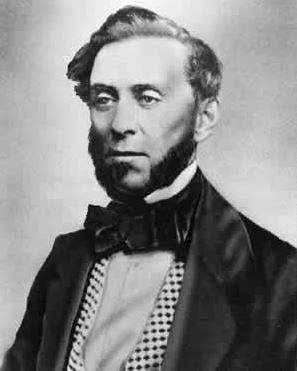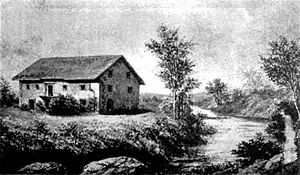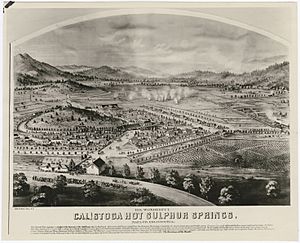Samuel Brannan facts for kids
Quick facts for kids
Samuel Brannan
|
|
|---|---|

Samuel Brannan
|
|
| Born | March 2, 1819 Saco, Massachusetts (District of Maine), United States
|
| Died | May 5, 1889 (aged 70) Escondido, California, United States
|
| Resting place | Mount Hope Cemetery, San Diego, California, United States |
| Spouse(s) |
|
| Partner(s) | Ashley |
| Children | Lucy rose Brannan |
Samuel Brannan (March 2, 1819 – May 5, 1889) was an American settler, businessman, and journalist. He was also a member of The Church of Jesus Christ of Latter-day Saints (LDS Church). He started the California Star, which was the first newspaper in San Francisco, California.
Samuel Brannan is known for being the first person to tell everyone about the California Gold Rush. He also became the first millionaire of the Gold Rush. He used the money he earned from his stores to buy a lot of land. He helped create the first group that worked to keep order in San Francisco. Later, he was no longer a member of the LDS Church because of some of his actions. His wife divorced him, and he had to sell much of his land to pay her. He passed away without much money and was not well-known at the end of his life.
Contents
Early Life and Beginnings
Samuel Brannan was born in Saco, Maine. When he was fourteen, he moved to Painesville, Ohio, with his sister and her husband. There, he learned how to be a printer.
In 1842, Samuel, his sister, and her husband joined the Church of Jesus Christ of Latter Day Saints in Kirtland, Ohio. After his father passed away, Brannan received some money. He used it to finish his printing training early and invested the rest in land. However, the market crashed, and his land lost its value. He then traveled to New Orleans and bought a printing press with his brother. Sadly, his brother died shortly after. Brannan then returned to Painesville.
Early Church Service
Back in Ohio, Brannan became more involved with the church. He was asked to serve as a missionary in Ohio. Before this, he had married Harriet ("Hattie") Hatch, and they were expecting their first child. He had to stop his mission early because he became sick.
After he got better, he was asked to help the church again as a printer in Connecticut. While there, Brannan met Ann Eliza Corwin and later married her.
In 1844, Brannan moved to New York City, New York. He started printing The Prophet, a church newspaper. Soon after, news came that the church leader Joseph Smith had been killed. Brannan worked with Joseph Smith's brother, William. For a short time, Brannan and William were not members of the church. However, Brannan asked to be allowed back into the church, and he was in May 1845.
Journey to California
After Joseph Smith's death, many church members decided to move west. Samuel Brannan became the highest-ranking church leader in New York. He was given the big job of helping the eastern church members move to California.
Brannan rented a ship called the Brooklyn. He convinced many church members in New York to join the trip to California. The Brooklyn sailed around Cape Horn in January 1846. Brannan was in charge of the journey. He brought a printing press and a flour mill to help with settling the new land.
The ship stopped in Honolulu, Hawaii, in June 1846 to get more supplies. While there, Brannan learned that the United States planned to take the Mexican port town of Yerba Buena. Brannan hoped to be the first to take the town. However, when the Brooklyn arrived at Yerba Buena on July 31, 1846, the U.S. Navy had already taken it a few days earlier. The church members began to settle in the area, which is now San Francisco. Their arrival greatly increased the population of the small town.
Life and Work in California
After settling in Yerba Buena, Brannan explored the area. He thought the land near the Sacramento River, which they called "New Hope," would be a good place for a new church community. However, this settlement did not last long due to disagreements.
Samuel Brannan is known for several "firsts" in California:
- He held the first non-Catholic wedding ceremony.
- He was the first to preach in English.
- He helped set up California's first public school.
- He built the first flour mill.
Brannan used his printing press to start the California Star. This was the first newspaper in San Francisco, and its first issue came out on January 9, 1847. It was the second newspaper in all of California. Later, in 1848, Brannan sold the paper, and it joined with another to become The Daily Alta California.
In June 1847, Brannan traveled to Green River, Wyoming. He met with Brigham Young, the new leader of the LDS Church. Brannan wanted Young to bring the church members to California, as had been planned earlier. But Young decided to settle in what is now Utah instead. Brannan returned to California feeling disappointed. As the only church leader in California, Brannan continued to collect money from church members. However, many members eventually stopped paying him and moved east toward Utah.
The California Gold Rush
In 1847, Brannan opened a store at Sutter's Fort, in today's Sacramento, California. He also built many large buildings in Sacramento and San Francisco. In early 1848, workers from John Sutter's mill paid for goods at Brannan's store with gold they had found.
Brannan's California Star newspaper could not print the news about the gold discovery because his staff had left to search for gold themselves. But Brannan owned the only store between San Francisco and the gold fields. He quickly bought all the picks, shovels, and pans he could find. Then, he ran through the streets of San Francisco, shouting, "Gold! Gold on the American River!" He had bought the pans for 20 cents each and sold them for $15 each. In just nine weeks, he made a huge amount of money.
Building San Francisco and Sacramento
In 1848, Brannan decided to use his money to help build up California and connect it with the eastern United States. He planned the California Star Express to deliver mail from San Francisco to Missouri.
Brannan opened more stores to sell goods to the gold miners. His store at Sutter's Fort alone sold a lot of goods each month in 1849. He also started buying a lot of land in San Francisco. He bought the remaining parts of the "New Hope" project. Like many others at this time, Brannan became very focused on making money.
Using his profits, Brannan bought more land from Sutter in the Sacramento area. Around this time, Brannan also started trading by ship with China, Hawaii, and the east coast. His land extended to southern California and even to Hawaii, where he bought large amounts of land in 1851. He and other landowners raised the price of land in California a lot, which made many people angry. This led to some conflicts over land.
Brannan became California's first millionaire. He was chosen to be part of the first town council of San Francisco in the new U.S. territory. In 1851, after some crimes in the area, he helped create a group called the San Francisco Committee of Vigilance. This group acted like a police force. In 1853, he was elected as a Senator for the California State Senate. By this time, California had become a state in 1850.
To help the west grow, Brannan bought California's first steam train. He wanted to speed up the building of the first western railroad. He also worked with other investors to build the first wharf (a pier for ships) in San Francisco. Brannan also spoke out against slavery.
In 1851, Samuel Brannan was no longer a member of the LDS Church. This was because of his actions as a leader of the Vigilantes.
Calistoga Resort
In 1859, Brannan visited some hot springs in the upper Napa Valley. He decided to build a new resort there. In 1861, he bought the land with the springs and founded the town of Calistoga. The name is said to be a mix of "California" and "Saratoga Springs," a famous resort in New York.
Brannan also started the Napa Valley Railroad in 1864. This made it easier for tourists to reach Calistoga from the ferry boats in the lower Napa Valley. The railroad was later sold in 1869. Some people in Calistoga were upset by Brannan's control of the area. Brannan was shot several times but survived. He used a cane for the rest of his life.
In 1870, Anna Eliza Corwin divorced Brannan. She had lived in Europe for a while, and they had grown apart. The judge ruled that she should receive half of their money and property. Since most of Brannan's wealth was in land, he had to sell many of his properties to pay her.
Later Years and Legacy
After his divorce, Samuel Brannan moved south to Mexico. He started a small ranch near the Mexican border. In 1880, the Mexican government gave him a large piece of land for helping them. In 1888, he received a payment from the Mexican government. Brannan traveled to San Francisco to pay his debts. He paid all his debts, but he passed away without enough money for his own funeral.
Samuel Brannan died at age 70 in Escondido, California, on May 5, 1889. His body was not claimed for over a year until it was recognized by chance. He was given a Christian burial, and for many years, only a simple marker showed his grave. He is buried at Mount Hope Cemetery.
Samuel Brannan's Legacy
Samuel Brannan left behind several important legacies:
- Brannan Street in San Francisco is named after him.
- He founded the California cities of Calistoga and Yuba City.
- He helped plan the unofficial areas that became the city of Sacramento.
- He is famous for shouting "Gold! Gold! Gold!" which helped start one of the biggest movements of people from all over the world to California.
See also
 In Spanish: Samuel Brannan para niños
In Spanish: Samuel Brannan para niños



